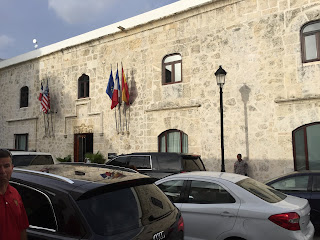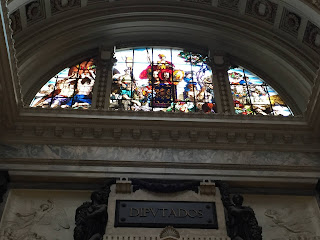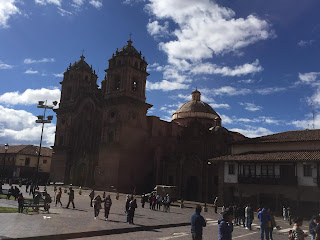Statue of Mary and Jesus downtown Lima
View of Pacific Ocean from my hotel in Lima. Cold, overcast, and dreary.
US Ambassador's house in Lima. Built in the 1940s.
Backyard patio
State dining room
Sitting room showing collections from Embassy Art Program; this ambassador likes quilts.
Cigar room where Vice President Pence met with Peru President a few weeks ago.
Main hall
Peru Navy shipyard. Most of their work is for other countries or businesses. In the background is a sub undergoing renovation. They've learned it's cheaper to cut the sub in half than try to keep it intact.
New ship undergoing sea trials. We got to tour it and our Navy classmates explained everything to us. Not piped aboard, but still fun.
View from the ramp of our C-17 just after landing in Cusco; altitude 11,000'
Village where we caught the train to Machu Picchu; if you look closely at the menu just to the left of the door, you'll see Guinea Pig (cuy) on the menu. I had an alpaca burger on the trip, but I just couldn't get over the fact I'd be eating a relative of my first pet if I tried cuy.
After a two hour bus ride, going to 12,400', it's another two hour train to Machu Picchu...only other option is to hike!
Stray dogs everywhere...super friendly
Snow on the mountain tops
Switchbacks are the bus route from the train station up to the park. Along the top of the picture, you can make out the Incan trail still used by hikers today. Machu Picchu is about 8,000'
Entrance to Machu Picchu
One of our tour guides, Nilo, pointing to the Sun gate (sunrise into the valley). Nilo is a history professor.
Me standing in front of the city. That's actually Little Mountain (not Machu Picchu) in the background, but it's the one seen in all the pictures. Machu Picchu is one of the new 7 Wonders of the World. This city was started in ~1450 and was abandoned about 80 years later. More on that later. If you get to the city early in the morning, you can get a permit to climb up Little Mountain; next time! During the growing season, the city had about 700 residents.
Sacred Valley. This is not their water source, but it was one of the physical borders protecting the city.
The round tower was incorrectly identified as a defensive position by American archaeologist Hiram Bingham when he discovered the city (by mistake, he was looking for another village) in 1911. It's actually a sun temple with windows that align to the summer and winter solstice. Many of the city's treasures are on display at Yale University. There is also a museum in Cusco.
View looking at the main temple in the city.
Close up and different angle of the sun temple. The reason modern archaeologists knew this was a temple and not a fighting position is because of the quality of the stone work. You'll see loose stone work in later pictures, but notice how tightly these stones fit together, indicating an important and holy place.
Llamas on the agricultural tiers. The soil on these garden layers matches soil from a location 60 miles away. The Incans carried this rich soil on their backs.
Just a cool picture through a doorway.
A tree growing in the courtyard. I can't remember who planted it, but it was brought in to demonstrate Incan word working techniques and was never removed; it's now one of the largest trees in the park.
Coca plant in the botanical garden where native plants are grown. Yes, these leaves are the primary ingredient for cocaine. Coca leave tea is served everywhere; we had to be careful of what we were offered to drink!
Close up of the stone work in the main temple. Again, note the quality stone masonry and tight fit of the massive stones--important and holy building.
Granite quarry that was source of all the stones in the city.
Another view of the main temple. Note the right side of the temple wall, likely caused by an earthquake. Modern archaeologists disagree if this "sign from god" or the arrival of the Spanish are what caused the Incans to abandon the city.
Temple of the three windows. Three is an important number in the Incan culture, represented by the Condor, Puma, and Snake. These windows align with the summer solstice and shine on the oddly shaped rock in the forefront, casting a shadow that completes an Incan Cross (
https://en.wikipedia.org/wiki/Chakana).
This is a sun calendar (think of a sun dial that tells time in months instead of hours); time was very important to the Incans to help them with agriculture.
Another view of the agricultural tiers. In the background, you can see Machu Picchu mountain.
Typical building. Notice the loose stone work compared to the temples. You can also see how they secured the thatch roofs to the buildings. Obviously the roofs are modern for educational purposes.
Saul, our other tour guide, talking about one of the neatest parts of the village. This is another thing Bingham got wrong; he thought these two stone bowls were mortars. But, they're flat, not round. These are astronomical water mirrors, filled with a thin layer of water. The Incans would study the reflection of the night sky in the mirrors to track the movement of the stars and help them with tracking time along with their sun calendars.
This is the Condor temple. The natural rocks on the left and right in the middle of the picture form the wings. The flat rock in the forefront is the Condor's head and the carved triangle is the beak. The two white semicircle stones represent the white feathers on the Condor. Evidence of animal sacrifices were found in the back of the temple. The Incans did not sacrifice humans, although older Andean tribes did.
I mentioned the Sacred Valley river was not the water source for the city. The Incans used snow melt from Machu Picchu for water via this aqueduct system feeding 14 fountains in the city that finally flowed to the agricultural tiers.
The aqueducts still work today as evidenced by the water flowing here.
Baby llama and momma llama. The Incans also raised guinea pigs, but a larger species than we know today. Horses, pigs, and cattle were brought by the Spanish.
Another stray. This little guy wanted to come home with me.
Statue of an anaconda (again, an important cultural symbol for the Incans) along the train route.
View of Cusco from my hotel.
One of many cathedrals in Cusco.
Cusco city gate.
Cathedral in Cusco. If I did okay with my bad Spanish skills, it celebrated its 600 year anniversary 10 August 2018.
Cathedral on the Plaza of the Armies
Another Cathedral on the Plaza of the Armies; this plaza is said to be the only in the world with two cathedrals.
There was a parade the morning we went into town celebrating the country's army and police.
Hike back up to our hotel at 11,600'...220 stairs!
Statue of the Inca, the god of the people.
















































































